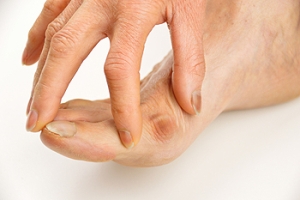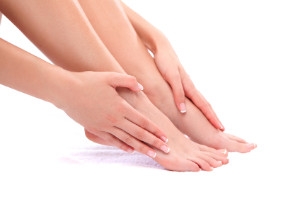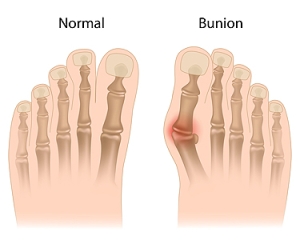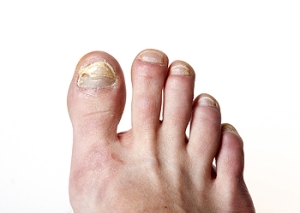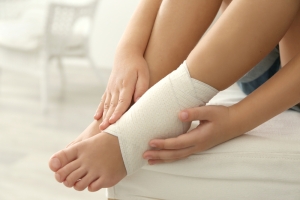
What is a Bunion?
 A large growth located on the foot at the bottom of the big toe is referred to as a bunion. It appears as an unsightly bony mass and may be caused by a predisposed inherited trait. Wearing high heels may cause the toes to remain in a cramped position for extended periods of time, and this can exacerbate an existing bunion. There are several ways to prevent this condition from occurring, including wearing shoes with a low heel or making sure a supportive feature, such as a strap, is present to prevent the foot from sliding. Additionally, it’s important to wear shoes with ample room to allow the toes to move freely. If you’re experiencing a bunion that’s causing severe pain, a consultation with a podiatrist is advised for possible treatment options.
A large growth located on the foot at the bottom of the big toe is referred to as a bunion. It appears as an unsightly bony mass and may be caused by a predisposed inherited trait. Wearing high heels may cause the toes to remain in a cramped position for extended periods of time, and this can exacerbate an existing bunion. There are several ways to prevent this condition from occurring, including wearing shoes with a low heel or making sure a supportive feature, such as a strap, is present to prevent the foot from sliding. Additionally, it’s important to wear shoes with ample room to allow the toes to move freely. If you’re experiencing a bunion that’s causing severe pain, a consultation with a podiatrist is advised for possible treatment options.
If you are suffering from bunions, contact one of our podiatrists of PA Foot & Ankle Associates. Our doctors can provide the care you need to keep you pain-free and on your feet.
What Is a Bunion?
A bunion is formed of swollen tissue or an enlargement of boney growth, usually located at the base joint of the toe that connects to the foot. The swelling occurs due to the bones in the big toe shifting inward, which impacts the other toes of the foot. This causes the area around the base of the big toe to become inflamed and painful.
Why Do Bunions Form?
Genetics – Susceptibility to bunions are often hereditary
Stress on the feet – Poorly fitted and uncomfortable footwear that places stress on feet, such as heels, can worsen existing bunions
How Are Bunions Diagnosed?
Doctors often perform two tests – blood tests and x-rays – when trying to diagnose bunions, especially in the early stages of development. Blood tests help determine if the foot pain is being caused by something else, such as arthritis, while x-rays provide a clear picture of your bone structure to your doctor.
How Are Bunions Treated?
- Refrain from wearing heels or similar shoes that cause discomfort
- Select wider shoes that can provide more comfort and reduce pain
- Anti-inflammatory and pain management drugs
- Orthotics or foot inserts
- Surgery
If you have any questions, please feel free to contact one of our offices located in Allentown, Easton, Northampton, and Chew Street in Allentown, PA . We offer the newest diagnostic and treatment technologies for all your foot care needs.
Bunions
A bunion is an enlargement of the base joint of the toe that connects to the foot, often formed from a bony growth or a patch of swollen tissues. It is caused by the inward shifting of the bones in the big toe, toward the other toes of the foot. This shift can cause a serious amount of pain and discomfort. The area around the big toe can become inflamed, red, and painful.
Bunions are most commonly formed in people who are already genetically predisposed to them or other kinds of bone displacements. Existing bunions can be worsened by wearing improperly fitting shoes. Trying to cram your feet into high heels or running or walking in a way that causes too much stress on the feet can exacerbate bunion development. High heels not only push the big toe inward, but shift one's body weight and center of gravity towards the edge of the feet and toes, expediting bone displacement.
A podiatrist knowledgeable in foot structure and biomechanics will be able to quickly diagnose bunions. Bunions must be distinguished from gout or arthritic conditions, so blood tests may be necessary. The podiatrist may order a radiological exam to provide an image of the bone structure. If the x-ray demonstrates an enlargement of the joint near the base of the toe and a shifting toward the smaller toes, this is indicative of a bunion.
Wearing wider shoes can reduce pressure on the bunion and minimize pain, and high heeled shoes should be eliminated for a period of time. This may be enough to eliminate the pain associated with bunions; however, if pain persists, anti-inflammatory drugs may be prescribed. Severe pain may require an injection of steroids near the bunion. Orthotics for shoes may be prescribed which, by altering the pressure on the foot, can be helpful in reducing pain. These do not correct the problem; but by eliminating the pain, they can provide relief.
For cases that do not respond to these methods of treatment, surgery can be done to reposition the toe. A surgeon may do this by taking out a section of bone or by rearranging the ligaments and tendons in the toe to help keep it properly aligned. It may be necessary even after surgery to wear more comfortable shoes that avoid placing pressure on the toe, as the big toe may move back to its former orientation toward the smaller toes.
Symptoms of Morton’s Neuroma
 Symptoms from a condition referred to as Morton’s neuroma can include intense pain often accompanied by a feeling of pins and needles. The third and fourth toes are mostly affected by the condition, which is typically caused by the nerve being squeezed. Weak arches may be the root of the pinched nerve, and a numbing sensation may be experienced. If there is scar tissue present around the nerve, that may be a factor as well. Shoes not fitting properly and pressing against a nerve may also be a possible cause for this condition to develop. It’s suggested to cease any activity that may increase the pain, in addition to resting the foot to allow for proper healing. Some treatments involve custom-made orthotics or taping the foot to ease the discomfort associated with Morton’s neuroma. When exercises are performed that aid in strengthening the arch, relief will be felt from the reduced pressure. Schedule a consultation with a podiatrist to learn about available treatment options for Morton’s neuroma.
Symptoms from a condition referred to as Morton’s neuroma can include intense pain often accompanied by a feeling of pins and needles. The third and fourth toes are mostly affected by the condition, which is typically caused by the nerve being squeezed. Weak arches may be the root of the pinched nerve, and a numbing sensation may be experienced. If there is scar tissue present around the nerve, that may be a factor as well. Shoes not fitting properly and pressing against a nerve may also be a possible cause for this condition to develop. It’s suggested to cease any activity that may increase the pain, in addition to resting the foot to allow for proper healing. Some treatments involve custom-made orthotics or taping the foot to ease the discomfort associated with Morton’s neuroma. When exercises are performed that aid in strengthening the arch, relief will be felt from the reduced pressure. Schedule a consultation with a podiatrist to learn about available treatment options for Morton’s neuroma.
Morton’s neuroma is a very uncomfortable condition to live with. If you think you have Morton’s neuroma, contact one of our podiatrists of PA Foot & Ankle Associates. Our doctors will attend to all of your foot care needs and answer any of your related questions.
Morton’s Neuroma
Morton's neuroma is a painful foot condition that commonly affects the areas between the second and third or third and fourth toe, although other areas of the foot are also susceptible. Morton’s neuroma is caused by an inflamed nerve in the foot that is being squeezed and aggravated by surrounding bones.
What Increases the Chances of Having Morton’s Neuroma?
- Ill-fitting high heels or shoes that add pressure to the toe or foot
- Jogging, running or any sport that involves constant impact to the foot
- Flat feet, bunions, and any other foot deformities
Morton’s neuroma is a very treatable condition. Orthotics and shoe inserts can often be used to alleviate the pain on the forefront of the feet. In more severe cases, corticosteroids can also be prescribed. In order to figure out the best treatment for your neuroma, it’s recommended to seek the care of a podiatrist who can diagnose your condition and provide different treatment options.
If you have any questions, please feel free to contact one of our offices located in Allentown, Easton, Northampton, and Chew Street in Allentown, PA . We offer the newest diagnostic and treatment technologies for all your foot care needs.
Morton's Neuroma
Morton's Neuroma, also called Intermetatarsal Neuroma or Plantar Neuroma, is a condition that affects the nerves of the feet, usually the area between the third and fourth toe. Neuroma refers to a benign growth that can occur in different parts of the body. Morton's Neuroma strictly affects the feet. This condition causes the tissue around the nerves that lead to the toes becoming thick, causing pain in the ball of the foot.
This condition can be caused by injury, pressure or irritation. Normally no lump will be felt, but instead burning pain in the ball of the foot will be experienced. Numbness and tingling may also occur. With the onset of this condition, a person may feel pain when tight or narrow shoes are worn. As the condition worsens, the pain may persist for days, or even weeks.
Persistent foot pain should always be a concern. The foot should be examined by a podiatrist if pain persists longer than a few days with no relief from changing shoes. The earlier the foot is examined and treated, the less chance there will be for surgical treatment.
There are some factors that can play a role in the development of Morton's Neuroma. These include wearing ill-fitting shoes that cause pressure to the toes, such as high heels. Also, high impact exercise may contribute to the cause of this condition. Morton’s Neuroma may also develop if the foot sustains an injury. Another cause includes walking abnormally due to bunions or flat feet. This causes excessive pressure and irritates the tissue. At times, people are affected for no determinable reason.
Podiatrists can alleviate the effects of this condition using a treatment plan to help decrease the pain and heal the foot tissue. Depending upon the severity of the Morton's Neuroma, the treatment plan can vary. For cases that are mild to moderate, treatments may include applying padding to the arch to relieve pressure from the nerve and reduce compression while walking. Ice packs can also help reduce swelling. The podiatrist may also create a custom orthotic device to support the foot and reduce compression and pressure on the affected nerve. The doctor will probably advise against partaking in activities that cause constant pressure on the affected area. They may provide wider shoes to ease the pressure from the toes. If these treatments do not relieve the symptoms of this condition, the doctor may use injection therapy.
Surgical treatment may be recommended by the podiatrist if all other treatments fail to provide relief. Normally, the podiatric surgeon will decide on either a surgical procedure that involves removal of the affected nerve or will choose surgery to release the nerve. After examination, the surgeon will decide on the best approach to treat the problem.
Recovery varies according to the type of surgical procedure. The patient will also be instructed on the best shoe wear to prevent the return of this condition, along with changes to workout routines, if this was a cause. Preventative measures are important in ensuring the condition does not return.
Why Do I Have a Bunion?
Hallux valgus is the scientific name for the condition commonly referred to as a bunion. This condition occurs when the bone between the joint and the base of the big toe protrudes, often causing pain and discomfort. An additional bone may form as a result of severe inflammation the bunion can cause, in addition to developing arthritis. The area may become red, tender, and swollen, and it’s suggested that larger-sized shoes are worn to replace shoes that do not provide adequate room for the bunion. There are several reasons why bunions may develop, including a predisposed inherited gene, improper shoes that are worn, or a condition referred to as flat feet. If the bunion is mild and tolerable, there may be conservative ways to treat this ailment. For more severe bunions, surgery may be a remedy to alleviate pain associated with this condition. A consultation with a podiatrist is recommended for additional information consisting of proper treatment techniques.
If you are suffering from bunions, contact one of our podiatrists of PA Foot & Ankle Associates. Our doctors can provide the care you need to keep you pain-free and on your feet.
What Is a Bunion?
A bunion is formed of swollen tissue or an enlargement of boney growth, usually located at the base joint of the toe that connects to the foot. The swelling occurs due to the bones in the big toe shifting inward, which impacts the other toes of the foot. This causes the area around the base of the big toe to become inflamed and painful.
Why Do Bunions Form?
Genetics – Susceptibility to bunions are often hereditary
Stress on the feet – Poorly fitted and uncomfortable footwear that places stress on feet, such as heels, can worsen existing bunions
How Are Bunions Diagnosed?
Doctors often perform two tests – blood tests and x-rays – when trying to diagnose bunions, especially in the early stages of development. Blood tests help determine if the foot pain is being caused by something else, such as arthritis, while x-rays provide a clear picture of your bone structure to your doctor.
How Are Bunions Treated?
- Refrain from wearing heels or similar shoes that cause discomfort
- Select wider shoes that can provide more comfort and reduce pain
- Anti-inflammatory and pain management drugs
- Orthotics or foot inserts
- Surgery
If you have any questions, please feel free to contact one of our offices located in Allentown, Easton, Northampton, and Chew Street in Allentown, PA . We offer the newest diagnostic and treatment technologies for all your foot care needs.
Bunions
A bunion is an enlargement of the base joint of the toe that connects to the foot, often formed from a bony growth or a patch of swollen tissues. It is caused by the inward shifting of the bones in the big toe, toward the other toes of the foot. This shift can cause a serious amount of pain and discomfort. The area around the big toe can become inflamed, red, and painful.
Bunions are most commonly formed in people who are already genetically predisposed to them or other kinds of bone displacements. Existing bunions can be worsened by wearing improperly fitting shoes. Trying to cram your feet into high heels or running or walking in a way that causes too much stress on the feet can exacerbate bunion development. High heels not only push the big toe inward, but shift one's body weight and center of gravity towards the edge of the feet and toes, expediting bone displacement.
A podiatrist knowledgeable in foot structure and biomechanics will be able to quickly diagnose bunions. Bunions must be distinguished from gout or arthritic conditions, so blood tests may be necessary. The podiatrist may order a radiological exam to provide an image of the bone structure. If the x-ray demonstrates an enlargement of the joint near the base of the toe and a shifting toward the smaller toes, this is indicative of a bunion.
Wearing wider shoes can reduce pressure on the bunion and minimize pain, and high heeled shoes should be eliminated for a period of time. This may be enough to eliminate the pain associated with bunions; however, if pain persists, anti-inflammatory drugs may be prescribed. Severe pain may require an injection of steroids near the bunion. Orthotics for shoes may be prescribed which, by altering the pressure on the foot, can be helpful in reducing pain. These do not correct the problem; but by eliminating the pain, they can provide relief.
For cases that do not respond to these methods of treatment, surgery can be done to reposition the toe. A surgeon may do this by taking out a section of bone or by rearranging the ligaments and tendons in the toe to help keep it properly aligned. It may be necessary even after surgery to wear more comfortable shoes that avoid placing pressure on the toe, as the big toe may move back to its former orientation toward the smaller toes.
How To Prevent Toenail Fungus
 If your toenails have turned yellow and are brittle and cracking, you may have what is referred to as toenail fungus. It is caused by a fungus that can get into the toenail through small cracks that are in the skin around the nails, and in more severe cases, extreme discomfort may be experienced. The surrounding skin may be susceptible to this fungus due to several reasons. These may include having a compromised immune system, an injury that has happened to the nail, or having athlete’s foot. Treatment options may include using an antifungal cream. In more severe cases, an oral medication is administered. Fungal infections are known to be stubborn. Several prevention techniques exist, including keeping the feet clean and dry, especially in between the toes, making sure your toenail clippers are not shared with anyone else, and wearing appropriate shoes in public showers. Please consider scheduling a consultation with a podiatrist for additional information about toenail fungus.
If your toenails have turned yellow and are brittle and cracking, you may have what is referred to as toenail fungus. It is caused by a fungus that can get into the toenail through small cracks that are in the skin around the nails, and in more severe cases, extreme discomfort may be experienced. The surrounding skin may be susceptible to this fungus due to several reasons. These may include having a compromised immune system, an injury that has happened to the nail, or having athlete’s foot. Treatment options may include using an antifungal cream. In more severe cases, an oral medication is administered. Fungal infections are known to be stubborn. Several prevention techniques exist, including keeping the feet clean and dry, especially in between the toes, making sure your toenail clippers are not shared with anyone else, and wearing appropriate shoes in public showers. Please consider scheduling a consultation with a podiatrist for additional information about toenail fungus.
For more information about treatment, contact one of our podiatrists of PA Foot & Ankle Associates. Our doctors can provide the care you need to keep you pain-free and on your feet.
Toenail Fungus Treatment
Toenail fungus is a condition that affects many people and can be especially hard to get rid of. Fortunately, there are several methods to go about treating and avoiding it.
Antifungals & Deterrence
Oral antifungal medicine has been shown to be effective in many cases. It is important to consult with a podiatrist to determine the proper regiment for you, or potentially explore other options.
Applying foot powder on the feet and shoes helps keep the feet free of moisture and sweat.
Sandals or open toed shoes – Wearing these will allow air movement and help keep feet dry. They also expose your feet to light, which fungus cannot tolerate. Socks with moisture wicking material also help as well.
If you have any questions please feel free to contact one of our offices located in Allentown, Easton, Northampton, and Chew Street in Allentown, PA . We offer the newest diagnostic tools and technology to treat your foot and ankle needs.
Toenail Fungus
Toenail fungus is a frustrating problem that affects many people. It can be persistent and hard to get rid of. As many different types of fungi are present throughout the environment, it is very easy to contract toenail fungus.
The feet are especially susceptible to toenail fungus because shoes and socks create the ideal dark and moist environment that fungal infections thrive in. While fungal infections of the nail plate are quite common, if left untreated they can spread beyond the toenail and into the skin and other parts of the body.
Signs of toenail fungus include a thickened nail that has become yellow or brown in color, a foul smell, and debris beneath the nail. The toe may become painful due to the pressure of a thicker nail or the buildup of debris.
Treatment for toenail fungus is most effective during the early stages of an infection. If there is an accumulation of debris beneath the nail plate, an ingrown nail or a more serious infection can occur. While each treatment varies between patients, your podiatrist may prescribe you oral medications, topical liquids and creams, or laser therapy. To determine the best treatment process for you, be sure to visit your podiatrist at the first signs of toenail fungus.
The Similarities Between A Sprained Ankle and Cuboid Syndrome
 A condition referred to as cuboid syndrome may have similar symptoms as those associated with an ankle sprain. Additionally, the discomfort and pain may be felt on the outside of the ankle and many patients overcompensate by rolling the arches inward. The bone that is called the cuboid bone is found on the outside of the foot, and dislocation may occur from an ankle injury. Treatment may typically consist of aligning the bone correctly in addition to applying tape and adequate padding which may keep the bone from slipping out of place. A condition that is often associated with this ailment is called peroneal tendonitis, which is an inflammation of the tendons that run behind the cuboid bone. For patients who are afflicted with peroneal tendonitis, a rehabilitation program may be suggested which may aid in gradual healing. Please consult with a podiatrist if additional information is required about cuboid syndrome.
A condition referred to as cuboid syndrome may have similar symptoms as those associated with an ankle sprain. Additionally, the discomfort and pain may be felt on the outside of the ankle and many patients overcompensate by rolling the arches inward. The bone that is called the cuboid bone is found on the outside of the foot, and dislocation may occur from an ankle injury. Treatment may typically consist of aligning the bone correctly in addition to applying tape and adequate padding which may keep the bone from slipping out of place. A condition that is often associated with this ailment is called peroneal tendonitis, which is an inflammation of the tendons that run behind the cuboid bone. For patients who are afflicted with peroneal tendonitis, a rehabilitation program may be suggested which may aid in gradual healing. Please consult with a podiatrist if additional information is required about cuboid syndrome.
Cuboid syndrome, also known as cuboid subluxation, occurs when the joints and ligaments near the cuboid bone in the foot become torn. If you have cuboid syndrome, consult with one of our podiatrists from PA Foot & Ankle Associates. Our doctors will assess your condition and provide you with quality foot and ankle treatment.
Cuboid syndrome is a common cause of lateral foot pain, which is pain on the outside of the foot. The condition may happen suddenly due to an ankle sprain, or it may develop slowly overtime from repetitive tension through the bone and surrounding structures.
Causes
The most common causes of cuboid syndrome include:
- Injury – The most common cause of this ailment is an ankle sprain.
- Repetitive Strain – Tension placed through the peroneus longus muscle from repetitive activities such as jumping and running may cause excessive traction on the bone causing it to sublux.
- Altered Foot Biomechanics – Most people suffering from cuboid subluxation have flat feet.
Symptoms
A common symptom of cuboid syndrome is pain along the outside of the foot which can be felt in the ankle and toes. This pain may create walking difficulties and may cause those with the condition to walk with a limp.
Diagnosis
Diagnosis of cuboid syndrome is often difficult, and it is often misdiagnosed. X-rays, MRIs and CT scans often fail to properly show the cuboid subluxation. Although there isn’t a specific test used to diagnose cuboid syndrome, your podiatrist will usually check if pain is felt while pressing firmly on the cuboid bone of your foot.
Treatment
Just as the range of causes varies widely, so do treatments. Some more common treatments are ice therapy, rest, exercise, taping, and orthotics.
If you have any questions, please feel free to contact one of our offices located in Allentown, Easton, Northampton, and Chew Street in Allentown, PA . We offer the newest diagnostic and treatment technologies for all your foot care needs.
Cuboid Syndrome
Cuboid syndrome mostly affects athletes, although it can affect non-athletes too. It is also known as cuboid subluxation or cuboid fault syndrome. This condition occurs when joints and ligaments near the cuboid bone of the foot are damaged, or when the cuboid bone itself is dislodged from its natural position. It is usually marked by pain on the outer side of the foot, which may be persistent or may come and go. Cuboid syndrome can be difficult to diagnose unless it becomes severe and more noticeable. Your doctor will likely ask questions about when the pain began and how long it has been present, and will put pressure on the cuboid bone to determine if that area is the origin of the pain.
Causes of Cuboid Syndrome
- Any repetitive stresses placed on the foot due to athletic activities are a common cause of cuboid syndrome.
- Although it develops over time, it is possible that this syndrome can occur all of sudden due to a single event or injury.
- Over-pronation can exacerbate the condition if not corrected.
Disagreements Amongst Podiatrists Regarding Cuboid Syndrome
- Some refer to it as the dislocation of the calcaneal-cuboid joint only.
- Other podiatrists see it as an injury of the ligaments located nearby, which also involves the cuboid bone.
It is very important that when you experience any kind of pain on the side of your foot, you should seek medical care right away. If a subluxed cuboid is caught early, your feet may respond well to the treatment, and you can get back into sports or other activities again as soon as the pain subsides.
